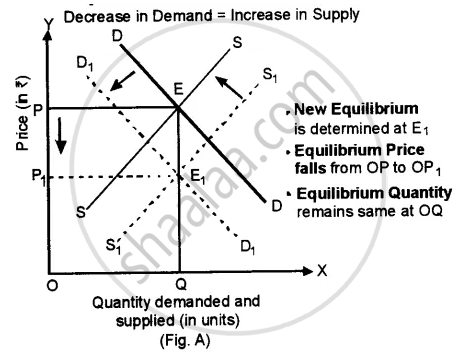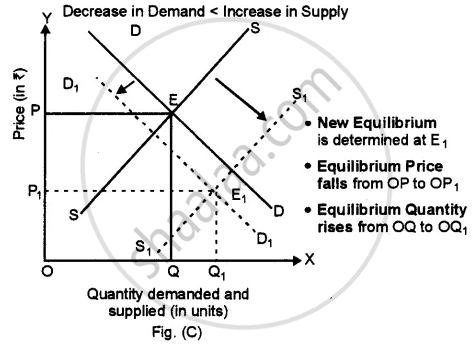Advertisements
Advertisements
Question
Answer the following question.
Show with the help of diagrams, the effect on equilibrium price and quantity when:
There is a fall in the price of substitute goods.
Solution
- A decrease in the price of a substitute good will disturb the equilibrium point and quantity of the commodity.
- Due to a decrease in the price of a substitute good (say coffee) demand for tea will fall because tea has become relatively costly.
- A decrease in the price of a substitute good will have a direct impact on the supply (supply will increase) of the good because produces of tea will like to clear their stock as fast as possible.
- The new equilibrium can be studied in three different cases.
Case 1: Decrease in Demand = Increase in Supply
When the decrease in demand is proportionately equal to the increase in supply, then the leftward shift in demand curve from DD to D1D1 is proportionately equal to a rightward shift in the supply curve from SS to S1S1.
(Fig. A). The new equilibrium is determined at E1. As the decrease in demand is proportionately equal to the increase in supply, equilibrium quantity remains the same at OQ, but equilibrium price falls from OP to OP1.

Case 2: Decrease in Demand > Increase in Supply
When a decrease in demand is proportionately more than an increase in supply, then the leftward shift in demand curve from DD to D1D1 is proportionately more than the rightward shift in the supply curve from SS to S1S1 (Fig. B). The new equilibrium is determined at E1. As the decrease in demand is proportionately more than the increase in supply, equilibrium quantity falls from OQ to OQ1 and equilibrium price falls from OP to OP1.

Case 3: Decrease in Demand < Increase in Supply
(i) When the decrease in demand is proportionately less than an increase in supply, then the leftward shift in demand curve from DD to D1D1 is proportionately less than a rightward shift in supply curve from SS to S1S1 Fig. C). The new equilibrium is determined at E1. As the decrease in demand is proportionately less than the increase in supply, equilibrium quantity rises from OQ to OQ1 whereas, equilibrium price falls from OP to OP1.

APPEARS IN
RELATED QUESTIONS
A market for a good is in equilibrium. The demand for the good 'increases'. Explain the chain of effects of this change.
A market for a good is in equilibrium. The supply of good "decreases". Explain the chain of effects of this change
A market for a product is in equilibrium. Demand for the product "decreases." Explain the chain of effects of this change till the market again reaches equilibrium. Use diagram
What is meant by 'excess supply' of a good in a market?
Draw average revenue and marginal revenue curves in a single diagram of a firm which can sell more units of a good only by lowering the price of that good. Explain.
Explain market equilibrium.
What will happen if the price prevailing in the market is
(i) above the equilibrium price?
(ii) below the equilibrium price?
How are equilibrium price and quantity affected when income of the consumers increase.
Using supply and demand curves, show how an increase in the price of shoes affects the price of a pair of socks and the number of pairs of socks bought and sold.
How will a change in price of coffee affect the equilibrium price of tea? Explain the effect on equilibrium quantity also through a diagram.
How do the equilibrium price and the quantity of a commodity change when price of input used in its production changes?
Considering the same demand curve as in exercise 22, now let us allow for free entry and exit of the firms producing commodity X. Also assume the market consists of identical firms producing commodity X. Let the supply curve of a single firm be explained as
qSf = 8 + 3p for p ≥ 20
= 0 for 0 ≤ p < 20
(a) What is the significance of p = 20?
(b) At what price will the market for X be in equilibrium? State the reason for your answer.
(c) Calculate the equilibrium quantity and number of firms.
Answer the following question.
Show with the help of diagrams, the effect on equilibrium price and quantity when:
There is a rise in the prices of inputs.
Rate of interest on savings account is more than that on recurring account.
